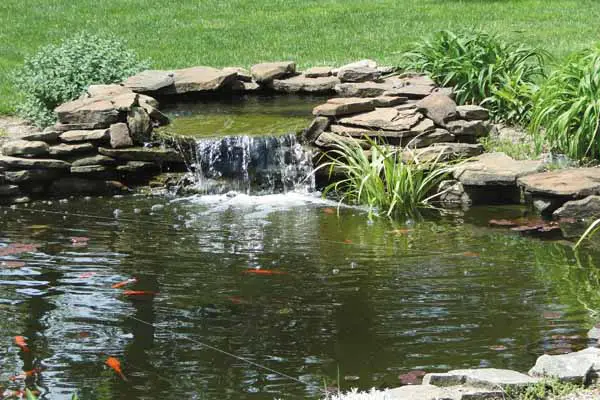Many turtle enthusiasts use indoor aquariums to keep their pets, but this enclosure is hard to clean and maintain. Most turtles will also outgrow an indoor aquarium. You have to consider the long-term needs of your pet turtles because these animals can live a really long life. A turtle pond can be an ingenious water feature that will provide your pet with a place where they can live peacefully and safely.
A turtle pond should be large. You need at least 1000 gallons of water for a turtle pond. Some portions of the pond should have remarkable depths, while others should be only several inches deep. One area should be at least 3′ feet. If you live in a place with a cold climate, there should be deeper areas where the turtles can hibernate.
You also need to provide a spot where they can leave the water to lay eggs or bask. If the female turtle can’t find a place to lay her eggs in, she will become ill and even need a trip to the veterinarian. You also need to design the pond’s layout properly to prevent the turtles from escaping and to keep hungry predators out.
How to Build a Turtle Pond
Ultimate DIY Turtle Pond BUILD!!!
Video Credits: DanTheGuppyMan
1. Gather the necessary materials.
You need ashovel, string, netting cover, plastic pond liner, logs, sand, hose, vegetation, and field stones to build a turtle pond.
2. Choose a location.
Build the pond in a shaded area where the turtles can retreat to. An area of the turtle pond should have direct sunlight, as it will serve as their basking spot. Make sure that the location of the pond won’t have debris blown into it.
3. Determine the pond’s size.
Ten gallons of water should be provided for every 1 sq in of turtle shell. To determine how big the hole should be, just follow this formula – length x width x depth (should be in feet) = volume of water in gallons. If you have a 5″ turtle, you need to dig a 6.5′ long x 4′ wide x 2′ deep hole into building a pond that can hold 50 gallons water. Don’t forget to measure an area of your backyard with a string that’s as long as the perimeter of the pond.
4. Start digging.
Dig the pond to a depth of 3′ to 4′. The pond should have shallow and deep sides. The shallow side should be in the sun so that the turtles can bask whenever they want. Use a plastic liner to cover the hole. Cut the lining and leave at least 1′ extra around the perimeter of the pond to prevent water overflow from seeping into the ground.
Secure the liner around the edges with the remaining dirt. Provide a soft part for the turtles to dig in or stand on by dumping some sand onto the bottom of the plastic pond liner. It also protects the liner and anchors the vegetation.
5. Create a barrier around the border of the pond.
Put the field stones around the border of the pond to prevent the turtles from escaping. The barrier should be at least 18″ in height. Put some stones, plants, and logs in the pond to give the turtles a place where they can bask and hide. The vegetation should not be an invasive species. It should be water plants.
6. Fill the turtle pond with water.
Make sure not to fill the pond with water to the brim. Switch the filtration system to make sure that it’s working properly. Cover the pond with a netting cover to keep predators out. The cover also gives easy access to the turtle pond.
Things to Consider When Building a Turtle Pond
Research
It’s important to conduct your own research before buying turtles. Since turtles that live in warm regions can’t survive in cold weather, it is best that you get turtles from cold or cool climates. The leaf litter amassing in the pond will serve as a hiding spot for cold-hardy turtles during winter. It will also provide them some warmth. If you want to raise turtles that come from warm regions, you should get them during the cool months.
Durability
You can build the pond with cement. This way, you can create a durable pond with a visually appealing shape. A pond liner is less durable and harder to form into various shapes than cement. If you’re going to build a cement pond, make sure that it is 3″ to 4″ thick. Embed chicken wire in the cement to make it stronger and use professional cement layers to apply the cement to achieve a finished surface. You also need to make sure that the pond will never leak or crack.
If you want to use a tarp to create a turtle pond, you should consider getting a canvas tarp. Black tarps absorb heat and trigger algae growth. Canvas tarps, on the other hand, are durable and available in a wide range of colors. Light tan canvas tarps create a natural look. Tarps are usually 100′ in length and 5′ in width. If you need a wider width, you can glue several sections together to achieve your desired result.
Security
You have to protect the turtles from predators such as cats, birds, raccoons, moles, opossums, and rats. The pond should have slanted sides with a rough surface so that turtles can exit or enter the pond with ease and stay safe from predators. Since the slope is slippery, you should be careful when cleaning the turtle pond.
Surround the land area with a fence or wall. You may want to choose a location that’s close to the house, so you can see the pond from a porch or window. A large dog can help deter potential predators, but the fence around the pond should be high enough that your pooch will not be able to enter the enclosure.
Water Quality
It might be a pain to remove falling leaf litter, but it’s actually a good thing because leaves can make the pond water more acidic. The pond will eventually have ph levels that hinder algae growth. Leaf sediment stays on the bottom of the pond, so the water remains clear.
Plant litter will clog the filter, so you may want to build a pond with no filter. If you really want a drain, you should have a deep or low drain area. In case you don’t have a drain, you can use a sump pump. However, you have to enclose it in a container that has holes to prevent clogs.
The filter should be cleaned every week. You also need to change the water on a regular basis. A clogged filter will reduce the quality of pond water. Change fifteen to twenty percent of the water every week. You can use the water that you removed from the pond to water plants because it’s rich in nitrates.
Shade and Sun
You should also provide a lot of shade. Algae will grow if the pond gets direct sunlight over many hours. Although turtles need sunlight in order for their shell to grow properly, they also require a shaded area where they can hide when it gets really hot. They need to have the right amount of shade and sun.
There should be a small area where they can bask in the sun safely. You should also provide basking logs in the water. Building the turtle pond beside your home can help block sunlight for several hours every day. You can also plant foliage that dangles over the water to provide a natural sunscreen to your pet turtles.
Feeding
Most turtle species are omnivores, so feeding them won’t be difficult. You can give them commercially prepared foods. Young turtles can be given mealworms, earthworms, silkworms, snails, crickets, feeder fish, and waxworms. You can also give them vegetables like kale and lettuce as well as common weeds such as dandelions. Just make sure that the weeds don’t have any pesticides on them.
You can also give them fruits, such as bananas. Don’t feed them spinach because it can cause calcium deficiency in turtles. Vegetables that are rich in purine such as peas and mushrooms should be avoided as well because they can cause gout.
If you don’t have a lot of space, you can build a small garden pond. It can be a room-sized area with bridges, plants, platforms around and over the pond and stepping stones. These elements will create a secluded and picturesque area for you and your pet turtles. A bridge provides security and shelter for the turtles. You can also place large plants around the edges of the pond. If you do include them, make sure that you can easily access them for occasional trimming. You have to build the bond first before you buy any turtle. It should be working properly as well. The habitat of any animal should be considered before getting one. Set up a pond that fits their needs, and your turtles will be healthy and happy. Make sure that the pond is durable so that you don’t have to spend money on repairs every now and then. Since turtles carry salmonella, you should wash your hands properly after handling them.



